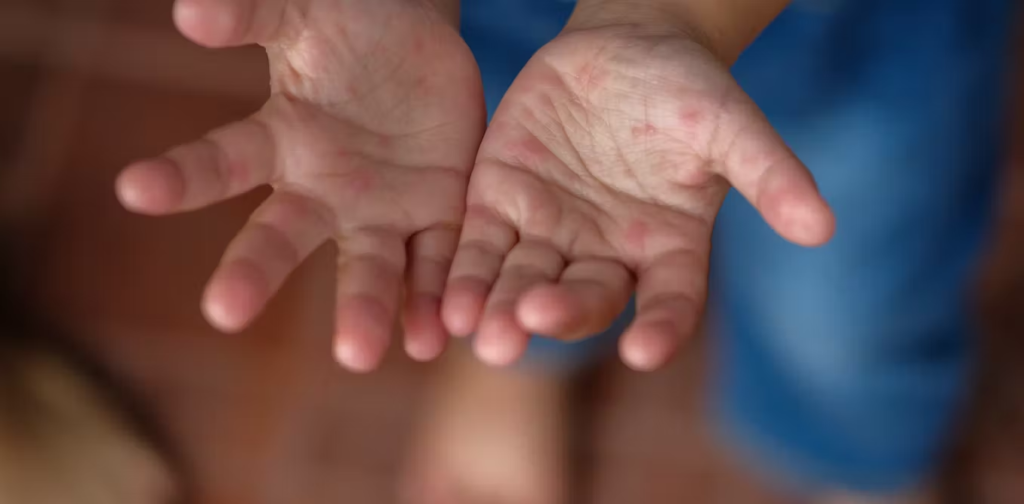
Imagine your little one waking up one morning with red spots on their hands, feet, and mouth. As a parent, this sight can be distressing, but fear not! It might be a case of Hand-Foot-and-Mouth Disease (HFMD), a common viral infection that primarily affects young children. In this comprehensive guide, we will explore everything you need to know about HFMD, from its causes, symptoms, and treatment, to prevention tips and what to expect during recovery.
Table of Contents
- Introduction
- What is Hand-Foot-and-Mouth Disease (HFMD)?
- What Causes HFMD?
- Recognizing the Symptoms
- HFMD in Infants and Toddlers
- Seeking Medical Care
- Home Remedies and Care Tips
- When Can My Child Return to School?
- Preventive Measures
- HFMD vs. Other Similar Illnesses
- HFMD Myth Busters
- HFMD and Pregnancy
- HFMD: Is it Contagious for Adults?
- The Emotional Toll on Parents
- Conclusion
- Frequently Asked Questions (FAQs)
1. Introduction
Hand-Foot-and-Mouth Disease (HFMD) is a contagious viral illness commonly found in young children, but it can also affect adults. While it is not a life-threatening condition, its uncomfortable symptoms can cause distress to both children and their parents. Understanding the causes, symptoms, and proper care for HFMD is crucial for managing the infection effectively.
2. What is Hand-Foot-and-Mouth Disease (HFMD)?
HFMD is a viral infection caused by the Enterovirus. The most common culprits are Coxsackievirus A16 and Enterovirus 71. These viruses primarily spread through close contact with an infected person’s respiratory secretions, blister fluids, or feces. The disease got its name from the characteristic sores that appear on the hands, feet, and inside the mouth.
3. What Causes HFMD?
As mentioned earlier, HFMD is caused by Enteroviruses, which thrive in warm and humid conditions. It is highly contagious and can spread rapidly in places like schools, daycare centers, and playgrounds. Children are more susceptible to the virus due to their underdeveloped immune systems, which make them easy targets for infections.
4. Recognizing the Symptoms
HFMD often starts with mild flu-like symptoms, such as fever, sore throat, and fatigue. After a day or two, the typical rash of small, red spots may appear on the palms, soles, and around the mouth. These spots can quickly develop into painful blisters. Raising awareness of these symptoms can help identify the infection early and prevent its spread.
5. HFMD in Infants and Toddlers
Young children, especially infants and toddlers, are at a higher risk of contracting HFMD due to their frequent hand-to-mouth activities and limited personal hygiene habits. Parents should closely monitor their children’s behavior and seek medical attention if they suspect HFMD.
6. Seeking Medical Care
While HFMD is usually a mild and self-limiting disease, it is essential to seek medical care for proper diagnosis and to rule out any complications. A healthcare professional can provide guidance on managing symptoms and offering relief to the affected child.
7. Home Remedies and Care Tips
Managing HFMD at home involves making the child as comfortable as possible. Offer cool, soft foods to soothe mouth sores, and ensure they stay hydrated. Over-the-counter pain relievers can also help ease discomfort. Remember to consult with a healthcare professional before administering any medication to your child.
8. When Can My Child Return to School?
One common concern among parents is when their child can safely return to school or daycare. Typically, children with HFMD can return once their fever subsides, and the blisters start to heal. It is crucial to follow the guidelines set by educational institutions to prevent further outbreaks.
9. Preventive Measures
Prevention is better than cure, and this holds true for HFMD. Encourage regular handwashing, especially after using the restroom and before meals. Avoid close contact with infected individuals and frequently disinfect commonly touched surfaces.
10. HFMD vs. Other Similar Illnesses
HFMD symptoms can be mistaken for other viral infections, such as chickenpox or herpangina. Understanding the unique characteristics of HFMD can help differentiate it from similar illnesses and ensure appropriate care is provided.
11. HFMD Myth Busters
There are numerous myths surrounding HFMD, leading to misconceptions and unnecessary panic. Let’s debunk some common myths and provide accurate information to create awareness.
12. HFMD and Pregnancy
Pregnant women may worry about the risks of HFMD to their unborn child. While the virus can cause discomfort for the mother, it rarely affects the baby. However, pregnant women should take necessary precautions to avoid the infection.
13. HFMD: Is it Contagious for Adults?
HFMD is not limited to children; adults can contract it too. The severity of symptoms in adults is generally milder than in children. However, adults should still take precautions to avoid transmitting the virus to others.
14. The Emotional Toll on Parents
Seeing your child in discomfort can be emotionally challenging for parents. Coping with the emotional aspects of managing HFMD is as crucial as the physical care provided to the child.
15. Conclusion
In conclusion, Hand-Foot-and-Mouth Disease (HFMD) is a viral infection that primarily affects children but can also impact adults. Being aware of the causes, symptoms, and preventive measures is essential for early detection and effective management. By maintaining good hygiene practices and seeking medical care when necessary, we can protect our little ones from the discomfort of HFMD.
16. Frequently Asked Questions (FAQs)
- Can adults get Hand-Foot-and-Mouth Disease?
- Yes, adults can also contract HFMD, but symptoms are usually milder.
- Is HFMD a severe illness for children?
- HFMD is generally a mild illness in children, but some cases may cause discomfort.
- How long does it take to recover from HFMD?
- The recovery period varies, but symptoms usually improve within a week.
- Can my child get HFMD again after recovering once?
- Yes, although rare, it is possible to get HFMD again as there are multiple strains of the virus.
- Can HFMD be prevented through vaccination?
- Currently, there is no specific vaccine for HFMD, but good hygiene practices can help prevent its spread.

External Links and Sources
For additional information about Hand-Foot-and-Mouth Disease, you can refer to the following reputable websites:
Centers for Disease Control and Prevention (CDC)
- World Health Organization (WHO)
- Mayo Clinic
- National Health Service (NHS) UK
Remember to consult these reputable sources for accurate and up-to-date information about HFMD.
Hand-Foot-and-Mouth Disease can be an unpleasant experience, but with proper care and precautions, it can be managed effectively. By understanding the symptoms, seeking medical attention when necessary, and implementing preventive measures, we can protect our children and ourselves from this viral infection.
It’s important to remember that each case of HFMD may differ, and it’s best to consult a healthcare professional for personalized advice. By staying informed and educated about this common childhood illness, we can promote a healthy and safe environment for our little ones.
In conclusion, Hand-Foot-and-Mouth Disease is a viral infection that primarily affects young children but can also impact adults. By adhering to proper hygiene practices and being aware of its symptoms, causes, and preventive measures, we can reduce the risk of HFMD and ensure a quicker recovery if it occurs. Remember, always seek medical advice if you suspect your child or yourself has contracted HFMD. Together, we can protect our loved ones from this contagious illness and keep them happy and healthy. Stay informed, take care, and enjoy the journey of parenthood!


